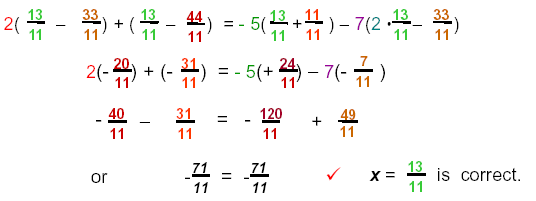Solving Linear Equations
In this section we will combine all of the methods that we have learned to solve
any
linear equation containing fractions, decimals, and parentheses. We will use all of
properties to simplify the expressions on both sides of the
equation.
DEFINITION A simple linear equation in one variable is any equation that can be
put in the form of ax + b = 0, where a and b are real numbers, a ≠ 0.
The alternate form of this equation is: Ax = B or A = Bx
Extend this to the general form of the equation.
General equation: Ax + B = Cx + D (A, B, C, D are real numbers.).
i) Simplify the equation so that there are only integers on both sides
ii) Many equations have enclosures which must first be simplified.
iii) Then solve simplified equations vertically - using the balance beam.
Pattern: ax + b = cx + d Both sides simplified (a ,b, c, d are integers.)
Look at the coefficients of x and determine which is the larger integer (furthest to
the right on the number line). If c > a then we will keep the variable x on that
side of
the equation and keep the constant on the other side. To do this we first add
opposites on the balance beam below the equation. Look at the pattern, and then
follow the same steps through several examples
Solve simplified equations vertically - using the balance beam .
Equation: a x + b = c x + d Both sides simplified (a ,b, c, d are integers.)
Pattern: c > a
1) Add opps:

Complete the step: (b - d) = (c - a)x → Let A =
(c - a) and B = (b - d)
Then B = Ax → A > 1 is coefficient of x
2) Multiply recip:

Example 1:
Solve 3(x − 2) = 5P
rocedure: 3(x − 2) = 5
| 1) Remove parentheses: 3x − 6 = 5
2) Add opps:
Complete the step: |
 |
Note: (5 + 6) = 11 |
Then 3x = 11 3 is the coefficient of x
3) Multiply recip:
 Since Since
 and
and

Then

4) Check in original equation: 3(x − 2) = 5
Replace in the equation:

Simplify equations that contain decimal fractions first by multiplying by the LCD.
Example 3:
Solve 2(x − 3) + (x − 4) = − 5 (x +1) − 7(2x – 3)
Procedure: 2(x − 3) + (x − 4) = - 5(x +1) − 7(2x – 3)
Remove parentheses: 2x − 6 + x − 4 = - 5x − 5 − 14x + 21 Distributive Property
Collect like terms: 3x − 10 = -19x + 16 Commutative Property
Simplify using balance beam:
| 1) Add opps: |
 |
Add same thing to both sides |
| |
|
| Complete the step: (3 + 19)x = +10 |
(3 + 19) = 22 and (16+10) = 26
|
| Then 22x = 26 |
22 is the coefficient of
x |
2) Multiply recip:
 |
Since
 |
Then

3) Check in original equation: 2(x − 3) + (x − 4) = - 5(x +1) − 7(2x – 3)
Replace x

|